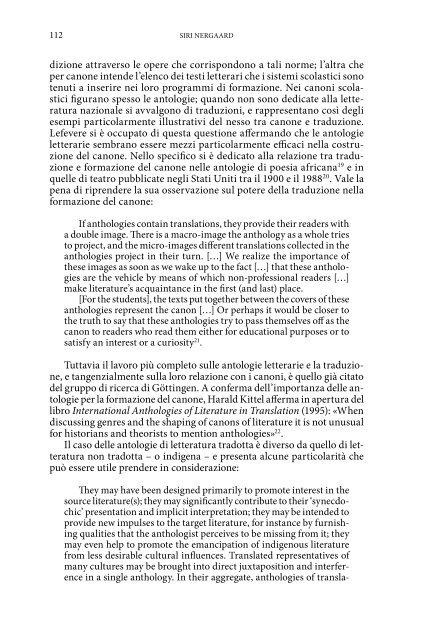Accesso aperto all'opera (PDF) - Firenze University Press
Accesso aperto all'opera (PDF) - Firenze University Press
Accesso aperto all'opera (PDF) - Firenze University Press
Create successful ePaper yourself
Turn your PDF publications into a flip-book with our unique Google optimized e-Paper software.
112<br />
siri nergaard<br />
dizione attraverso le opere che corrispondono a tali norme; l’altra che<br />
per canone intende l’elenco dei testi letterari che i sistemi scolastici sono<br />
tenuti a inserire nei loro programmi di formazione. nei canoni scolastici<br />
figurano spesso le antologie; quando non sono dedicate alla letteratura<br />
nazionale si avvalgono di traduzioni, e rappresentano così degli<br />
esempi particolarmente illustrativi del nesso tra canone e traduzione.<br />
lefevere si è occupato di questa questione affermando che le antologie<br />
letterarie sembrano essere mezzi particolarmente efficaci nella costruzione<br />
del canone. nello specifico si è dedicato alla relazione tra traduzione<br />
e formazione del canone nelle antologie di poesia africana 19 e in<br />
quelle di teatro pubblicate negli stati uniti tra il 1900 e il 1988 20 . Vale la<br />
pena di riprendere la sua osservazione sul potere della traduzione nella<br />
formazione del canone:<br />
if anthologies contain translations, they provide their readers with<br />
a double image. There is a macro-image the anthology as a whole tries<br />
to project, and the micro-images different translations collected in the<br />
anthologies project in their turn. […] We realize the importance of<br />
these images as soon as we wake up to the fact […] that these anthologies<br />
are the vehicle by means of which non-professional readers […]<br />
make literature’s acquaintance in the first (and last) place.<br />
[for the students], the texts put together between the covers of these<br />
anthologies represent the canon […] or perhaps it would be closer to<br />
the truth to say that these anthologies try to pass themselves off as the<br />
canon to readers who read them either for educational purposes or to<br />
satisfy an interest or a curiosity 21 .<br />
tuttavia il lavoro più completo sulle antologie letterarie e la traduzione,<br />
e tangenzialmente sulla loro relazione con i canoni, è quello già citato<br />
del gruppo di ricerca di göttingen. a conferma dell’importanza delle antologie<br />
per la formazione del canone, Harald Kittel afferma in apertura del<br />
libro International Anthologies of Literature in Translation (1995): «When<br />
discussing genres and the shaping of canons of literature it is not unusual<br />
for historians and theorists to mention anthologies» 22 .<br />
il caso delle antologie di letteratura tradotta è diverso da quello di letteratura<br />
non tradotta – o indigena – e presenta alcune particolarità che<br />
può essere utile prendere in considerazione:<br />
They may have been designed primarily to promote interest in the<br />
source literature(s); they may significantly contribute to their ‘synecdochic’<br />
presentation and implicit interpretation; they may be intended to<br />
provide new impulses to the target literature, for instance by furnishing<br />
qualities that the anthologist perceives to be missing from it; they<br />
may even help to promote the emancipation of indigenous literature<br />
from less desirable cultural influences. translated representatives of<br />
many cultures may be brought into direct juxtaposition and interference<br />
in a single anthology. in their aggregate, anthologies of transla-

















